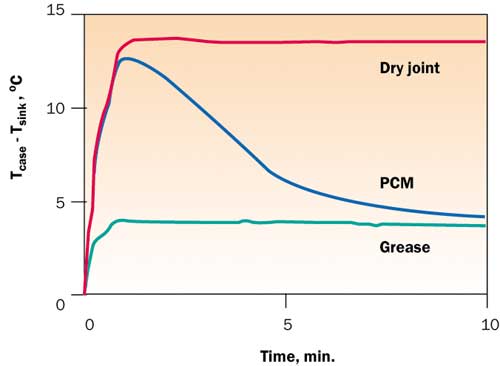Although phase change materials (PCM) were introduced nearly twenty years ago, it was not until the development of the high-powered Pentium processor that this class of interface material gained widespread acceptance. The large quantities of heat produced by these processors necessitated a carefully designed thermal path where all of the thermal resistances were minimized. For the case-to-heatsink interface, this required that thermal grease be used to minimize the interface resistance. Fortunately, PCM’s provided an alternative to the messy application and the migration problems associated with thermal grease.
The term “phase change” describes a class of materials that is solid at room temperature and that changes to a liquid as its temperature increases. This phase change, or melting, occurs in the range of 40 to 70oC. PCM’s are composed of a mixture of organic binders, fine particle ceramic fillers for thermal enhancement, and, optionally, a supporting substrate, such as aluminum foil or a woven glass mesh. The organic binder is a blend of a polymer and a low-melt-point crystalline component, such as a wax. The ceramic fillers may be Al2O3, BN, AlN or ZnO. PCM’s can be supplied in reel form, but end users prefer to have the heatsink supplier attach them directly.
The way a PCM performs as compared to a dry joint and thermal grease appears in Figure 1. A pin fin heatsink is attached to a microprocessor with spring clips that provide approximately 35 kPa (5 psi) of compressive force. Power is applied and the temperature of the case and the heatsink are recorded until thermal equilibrium is reached. The temperature difference is plotted against elapsed time. The curve representing the dry joint shows a rapid establishment of thermal equilibrium at about 13oC. The curve for the thermal grease shows the same rapid steady state development but at a much lower temperature difference of 4oC. The thermal grease has significantly reduced the interface resistance by eliminating the interstitial air.
 |
Figure 1. Performance of a PCM, compared to a dry joint and thermal grease.
The PCM – a 0.13 mm thick dry film – behaves as a combination of the two interfaces shown above. As the power is turned on and the components are still cool, the system behaves like a dry joint and the temperature difference rapidly increases to about 13oC. As the system temperature increases, the PCM melts and the clamping pressure exerted by the spring clips forces the liquid to spread in the thermal joint. As the liquid spreads, the molten PCM displaces the interstitial air and the distance between the surfaces decreases. Both of these processes act to reduce the thermal resistance of the interface and the temperature difference is seen to decrease fairly rapidly, reaching the performance of thermal grease. In effect, the solid PCM film has turned into thermal grease and a grease-like joint has been formed. The next time the processor is turned on, the interface will not experience the large temperature difference because the thermal joint has already been established.
The thermal resistance across an interface depends on the thermal conductivity of the PCM in the interface and its conductive path length. Thermal conductivity is a function of the type and level of the ceramic filler in the formulation, typically between 0.7 and 1.5 W/m-K. The amount of filler that can be added is limited by the need to keep the viscosity of the PCM as low as possible to achieve proper flow in the interface. The thickness of the interface formed by a PCM is determined by the flatness of the mating surfaces, the clamping pressure, and the viscosity and rheology of the molten PCM. Most commercial surfaces deviate from true flatness by as much as 2 �m/mm (2 mils/inch). This means that the thermal path between a processor surface and the heatsink may be as much as 100 �m (4 mils). With large heatsinks this value may be even greater. Critical applications may require a better surface flatness through additional operations to reduce the thermal path.
The viscosity and the rheology of the PCM above its melt point represent another factor determining the thickness of the interface. As the PCM melts in the interface, the pressure applied by the spring clips forces the liquid to spread eliminating the interstitial air and allowing the two surfaces to approach each other. If the viscosity is high, the low force of the springs will be insufficient to cause much spreading and the conduction path will be long. Low viscosity on the other hand will allow the liquid to fill most of the joint, resulting in the thinnest joint. Using stronger springs will aid the spreading process, but there is a limit to the amount of pressure that can be applied to these often-sensitive systems.
In conclusion, phase change materials offer the same thermal performance as thermal grease without the mess and contamination associated with grease. They can be supplied attached to a heatsink as a dry film. As soon as they are heated above their phase change temperature, they melt and perform as well as, or often better than, thermal grease. Once this interface has been formed, it remains stable until the sink is physically removed from the processor surface.






